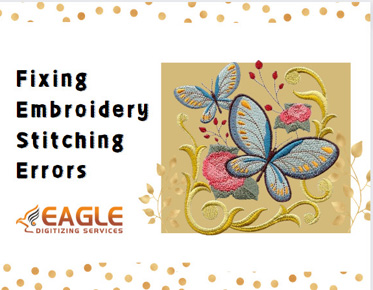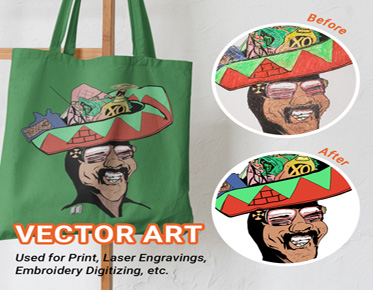Fixing Embroidery Stitching Errors: Tips and Tricks
Embroidery, a cherished craft admired for its intricate designs and delicate stitches, is an art form that often demands precision and patience. Despite one's proficiency in embroidery, encountering stitching errors is not uncommon. These errors can vary in nature, from minor imperfections to more significant setbacks that require careful attention and troubleshooting. In this comprehensive guide, we will explore the nuances of fixing embroidery stitching errors, offering invaluable tips, tricks, and techniques to help enthusiasts overcome common challenges and elevate the quality of their embroidery work. Read Here are Some Things That You Should Know When It Comes To Embroidery Digitizing!
Understanding
Common Embroidery Stitching Errors
Embroidery stitching errors can arise from a myriad of factors, each contributing to deviations from the intended design. By understanding these common errors, embroiderers can better anticipate challenges and devise effective solutions.
Thread
Tension Issues
Thread tension plays a pivotal role in achieving optimal stitch quality. When thread tension is improperly adjusted, it can manifest in two primary forms:
Loose Stitches:
● Loose stitches result from insufficient tension, causing threads to
appear slack and uneven. These loose stitches compromise the integrity of the
embroidery design, leading to a lackluster appearance.
Tight
Stitches:
● Conversely, overly tight stitches occur when tension is excessively high, causing threads to pull tightly against the fabric. This can result in puckering or distortion of the fabric, detracting from the overall aesthetics of the design.
Thread
Breakage
Thread breakage during embroidery can be frustrating and disruptive, halting progress and requiring meticulous troubleshooting. Common causes of thread breakage include:
Improper Thread Tension:
●
Inconsistent thread tension can
place undue stress on the thread, leading to breakage. Adjusting the tension
settings on the embroidery machine or manually can help alleviate this issue.
Needle
Issues:
● Dull or bent needles can cause excessive friction and wear on the thread, increasing the likelihood of breakage. Using sharp, straight needles of the appropriate size is essential for minimizing thread breakage.
Needle
Problems
The needle is a critical component of the embroidery process, and issues with the needle can significantly impact stitch quality. Common needle-related problems include:
Bent or Dull Needles:
● Bent or dull needles can result in uneven stitching and thread breakage.
Inspecting needles regularly and replacing them when signs of wear are evident
is essential for maintaining optimal stitch quality.
Wrong
Needle Size:
● Selecting the wrong needle size for the fabric and thread being used can lead to stitching errors. Using needles that are too large may cause visible puncture holes in delicate fabrics, while needles that are too small may struggle to accommodate thicker threads.
Fabric
Puckering
Fabric puckering occurs when the fabric gathers or wrinkles during the embroidery process, resulting in an unsightly finish. This issue can be attributed to various factors, including:
Insufficient Stabilization:
● Inadequate stabilization of the fabric can exacerbate fabric puckering. Using embroidery stabilizers appropriate for the fabric type can help mitigate this issue and ensure smooth stitching.
Uneven
Stitching
Uneven stitching, characterized by irregular stitch lengths or spacing, can detract from the overall quality of the embroidery design. Several factors can contribute to uneven stitching, including:
Inconsistent Thread Tension:
● Fluctuations in thread tension can result in uneven stitching.
Achieving consistent tension settings and ensuring proper bobbin tension is
essential for uniform stitch formation.
Hooping
Techniques:
● Improper hooping techniques, such as uneven tension or misalignment of the fabric, can lead to uneven stitching. Taking care to hoop the fabric securely and evenly can help mitigate this issue.
Tools
and Materials for Fixing Embroidery Stitching Errors
Equipping oneself with the appropriate tools and materials is essential for effectively addressing embroidery stitching errors. A well-stocked embroidery repair kit should include:
Seam Ripper or Embroidery Scissors:
●
These tools are indispensable for
precise stitch removal, allowing embroiderers to correct errors without causing
damage to the surrounding fabric.
Tweezers:
●
Tweezers are useful for handling
delicate threads and picking out stubborn stitches that may be difficult to
remove with other tools.
Thread
Conditioner:
●
A thread conditioner can help
prevent thread breakage by lubricating the thread and reducing friction as it
passes through the fabric and needle.
Embroidery
Stabilizers:
● Stabilizers provide support to the fabric during embroidery, minimizing distortion and puckering. Various types of stabilizers are available, ranging from tear-away to water-soluble, each suited to different fabric types and embroidery techniques.
Step-by-Step
Guide to Fixing Embroidery Stitching Errors
When confronted with embroidery stitching errors, a systematic approach to troubleshooting and repair is essential. Follow these step-by-step guidelines to address common stitching errors effectively:
1. Assess
the Error
Begin by carefully examining the stitching error to identify the root cause(s) behind it. Whether it's loose stitches, thread breakage, or uneven stitching, understanding the underlying issue is crucial for implementing the appropriate solution.
2.
Remove Stitches
Using a seam ripper or embroidery scissors, gently remove the erroneous stitches, taking care to avoid damaging the surrounding fabric. Work methodically, gradually undoing the stitches until the affected area is clear.
3.
Address Thread Tension Issues
If the stitching error is attributable to thread tension issues, adjust the tension settings on your embroidery machine or manually adjust the tension dial until the desired tension is achieved. Test the tension adjustments on a scrap piece of fabric before resuming embroidery to ensure optimal results.
4.
Replace Broken Threads
In cases of thread breakage, replace the broken threads with fresh ones of the same color and type. Thread the machine carefully, ensuring smooth continuity in your embroidery design without visible gaps or inconsistencies.
5.
Change Needles
If needle-related issues are suspected, such as bent or dull needles, replace the needle with a new one of the appropriate size and type for your fabric and thread. Dispose of the old needle properly to prevent accidental injury.
6. Use
Stabilizers
To prevent fabric puckering and ensure smooth stitching, use embroidery stabilizers appropriate for your fabric type. Hoop the fabric and stabilizer together securely, ensuring even tension across the entire embroidery area.
7.
Correct Uneven Stitching
If uneven stitching is observed, adjust thread tension, hooping techniques, or stitch settings as necessary to achieve uniform stitch formation. Experiment with different settings and techniques until the desired results are achieved.
Preventive
Measures to Avoid Embroidery Stitching Errors
While knowing how to fix embroidery stitching errors is invaluable, implementing preventive measures to avoid them altogether is equally important. Here are some proactive steps you can take to minimize the occurrence of stitching errors in your embroidery projects:
Properly Adjust Thread Tension:
●
Take the time to calibrate thread
tension settings on your embroidery machine, ensuring balanced stitching and
minimizing the risk of thread breakage.
Regular
Maintenance:
●
Maintain your embroidery machine
regularly by cleaning it and lubricating moving parts as recommended by the
manufacturer. Routine maintenance can help prevent issues such as needle jams
and tension inconsistencies.
Quality
Materials:
●
Invest in high-quality embroidery
materials, including threads, needles, and embroidery stabilizers, to ensure
optimal performance and minimize the likelihood of stitching errors. Quality
materials are more durable and less prone to breakage or malfunction, resulting
in smoother embroidery outcomes.
Practice
on Scrap Fabric:
● Before embarking on a new embroidery project, practice stitching on scrap fabric to familiarize yourself with your machine settings and techniques. This allows you to identify potential issues and refine your skills in a low-risk environment before working on your final piece.
Advanced
Tips and Tricks for Fixing Complex Stitching Errors
For embroiderers seeking to refine their skills and tackle more intricate stitching errors, advanced techniques offer innovative solutions to complex challenges:
Blend Thread Colors Seamlessly:
●
When faced with thread color
mismatches or transitions, employ blending techniques to seamlessly merge
different thread colors. By strategically layering and blending threads, you
can create smooth transitions and achieve a cohesive embroidery design.
Repair
Intricate Designs:
●
In the event of missing or damaged
areas in intricate embroidery designs, employ meticulous restitching techniques
to restore the integrity of the design. Match stitch lengths and densities
precisely to seamlessly integrate repaired sections with the surrounding
embroidery.
Handle
Delicate Fabrics with Care:
● When correcting stitching errors on delicate fabrics such as silk or lace, exercise caution to avoid causing further damage. Use gentle techniques and lightweight stabilizers to support the fabric without compromising its delicate texture.
Troubleshooting
Common Problems in Fixing Stitching Errors
Despite careful attention to detail, embroiderers may encounter challenges when attempting to fix stitching errors. Here are some common issues that may arise during the troubleshooting process and strategies for addressing them:
Stubborn
Thread Residues:
●
Stubborn thread residues left
behind after stitch removal can be challenging to remove, especially on
delicate fabrics. Use tweezers or a small brush to gently coax out residual
threads without causing further damage to the fabric.
Fabric
Distortion:
●
Fabric distortion, particularly on
lightweight or stretchy fabrics, may occur during stitch removal. To prevent
distortion, place a piece of stabilizer underneath the fabric to provide
support and distribute tension evenly during stitch removal.
Repeated
Errors:
● If stitching errors persist despite troubleshooting efforts, it may indicate underlying issues with your embroidery machine or techniques. Consult experienced embroiderers or technicians for personalized advice and assistance in identifying and resolving the root cause of the recurring errors.
Seeking
Professional Help for Stubborn Embroidery Stitching Errors
In cases where DIY troubleshooting proves ineffective, seeking professional assistance can provide invaluable insights and solutions to stubborn stitching errors:
Consult
Experienced Embroiderers or Technicians:
●
Experienced embroiderers and
technicians possess specialized knowledge and expertise in diagnosing and
resolving complex stitching errors. Seek their guidance and advice to overcome
stubborn challenges and achieve optimal embroidery results.
Utilize
Online Resources and Forums:
● Online resources and forums offer a wealth of information and support for embroiderers facing stitching errors. Engage with online communities, ask questions, and share experiences to benefit from collective wisdom and diverse perspectives.
Conclusion
Embroidery stitching errors are an inevitable
part of the creative process, but they need not be insurmountable obstacles.
With the right tools, techniques, and mindset, embroiderers can address common
challenges effectively and enhance the quality of their embroidery work. By understanding
the root causes of stitching errors, implementing preventive measures, and
leveraging advanced techniques when needed, embroiderers can overcome obstacles
with confidence and creativity. Embrace mistakes as learning opportunities, and
let them inspire you to elevate your embroidery skills to new heights. Happy
stitching!



